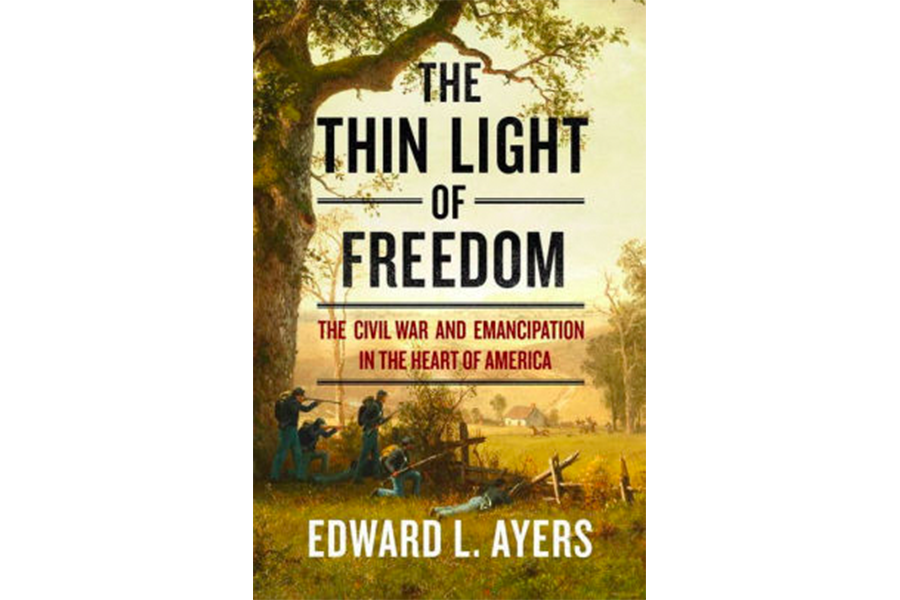'The Thin Light of Freedom' is a Civil War history that explores the forging of modern America
Loading...
American Civil War historian Edward Ayers, in his new book The Thin Light of Freedom: Civil War and Emancipation in the Heart of America, constructs an extended, elegant study of rifts, of chasms, beginning with a spectacular rift in the Earth itself: the Great Appalachian Valley, which stretches from Quebec to Alabama in a 1,200-mile gouge along the Appalachian Mountains and crosses the Mason-Dixon Line at the border of Pennsylvania, forming the chasm between the two counties that serve as Ayers' focus in this book, Augusta County in Virginia and Franklin County in Pennsylvania.
Even before war erupted in 1860, these counties and their people had been pitted against each other by rising tensions over the question of slavery, with the Fugitive Slave Law compelling Northerners to capture and return slaves who had escaped to their territory. Some of these escaped slaves were among Franklin County's 1,800 African-Americans, and the thorny issue of their fate divided communities and even families. “Some white people in Franklin County sympathized with the slaveholders who lived just across the border and even captured escaped slaves for those slaveholders,” Ayers writes. “On the other hand, white and black abolitionists in the county had long aided fugitives from slavery, steering them through the mountain passes to more secure freedom farther north.”
Franklin County's white population was almost twice as large as that of Augusta County, where, as Ayers writes, “black and white people had lived alongside each other for more than a century by the time war descended on the Valley.” The war battened onto the county's slave population, in an irony Ayers isn't the first to point out: The Southern states rebelled in large part as an assertion of their own regional sovereignty, and yet with the coming of war those states found themselves under a far more exacting concentrated federal power, “to a degree unimaginable and unacceptable, before secession,” Ayers observes. “Whether it was the draft of soldiers, demands for the labor of enslaved people, impressment of food and animals, heavy taxation, or control of the money supply, white Southerners watched as their new central government reached into every aspect of their lives.”
Those impositions by the Confederate government reached a pitched level as the war increasingly turned against the South, and the crucial breaking point came with one of the most memorable set-pieces of Ayers's book, the Battle of Gettysburg, in which General Robert E. Lee's audacious move north with his army seemed to bring the whole conflict into sharp relief. “The invasion of Pennsylvania was not the reckless gamble it seemed to many above and below the Mason-Dixon Line,” Ayers writes, “but a grim reckoning with reality.”
This, too, is one of the critical breaking points in "The Thin Light of Freedom." "The scale of the armies descending on Pennsylvania, the limitless hunger they brought with them, their capacity to devastate all they came near, could barely be comprehended,” Ayers writes. “They descended like storms, relentless and unavoidable.”
The book kicks off with that doomed invasion of Pennsylvania and extends through the end of the war and the miseries of Reconstruction to 1870 and the passage of the Fifteenth Amendment. Ayers makes the wise decision to anchor the sweep of his historical narrative in a small cast of ordinary people trooping in and out of his two counties, from “unlikely Confederate” and New York transplant Jedediah Hotchkiss to African-American Union recruit Jacob Christy to Rachel Cormany, wife of a Confederate soldier who worried with him through the war's harrowing final years, to Willis Carter, a slave who worked his way into prominence as a teacher and administrator after the war. It's through these individual stories that Ayers's book achieves its most gripping reading stretches, dramatizing as few recent books have done the dual, entwined wars taking place in the years it chronicles – one a war of soldiers and battlefields, the other a war of social justice and the fight to enlarge the promise of liberty.
Small towns throughout the Great Valley changed hands many times during war, and as complicated a military picture as that presents, it represents an even more complicated political and social picture. "The Thin Light of Freedom" gathers the stories of all these different aspects of the war's final years and transmutes them into a dark and oddly uplifting tale of the forging of modern America. It's a necessary addition to Civil War libraries.








